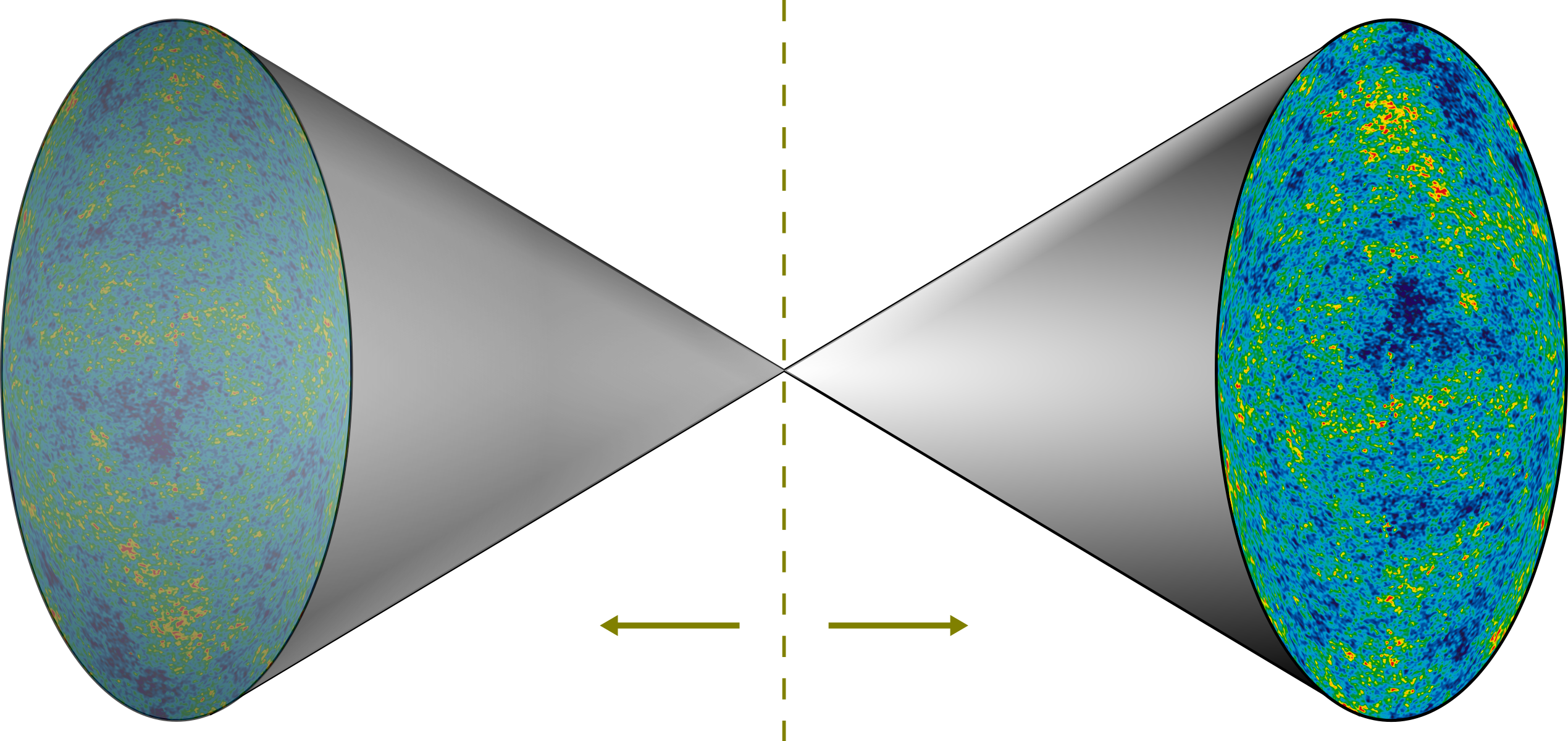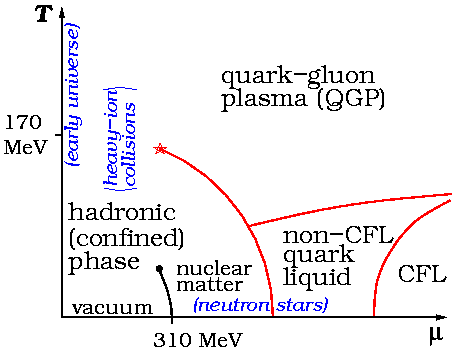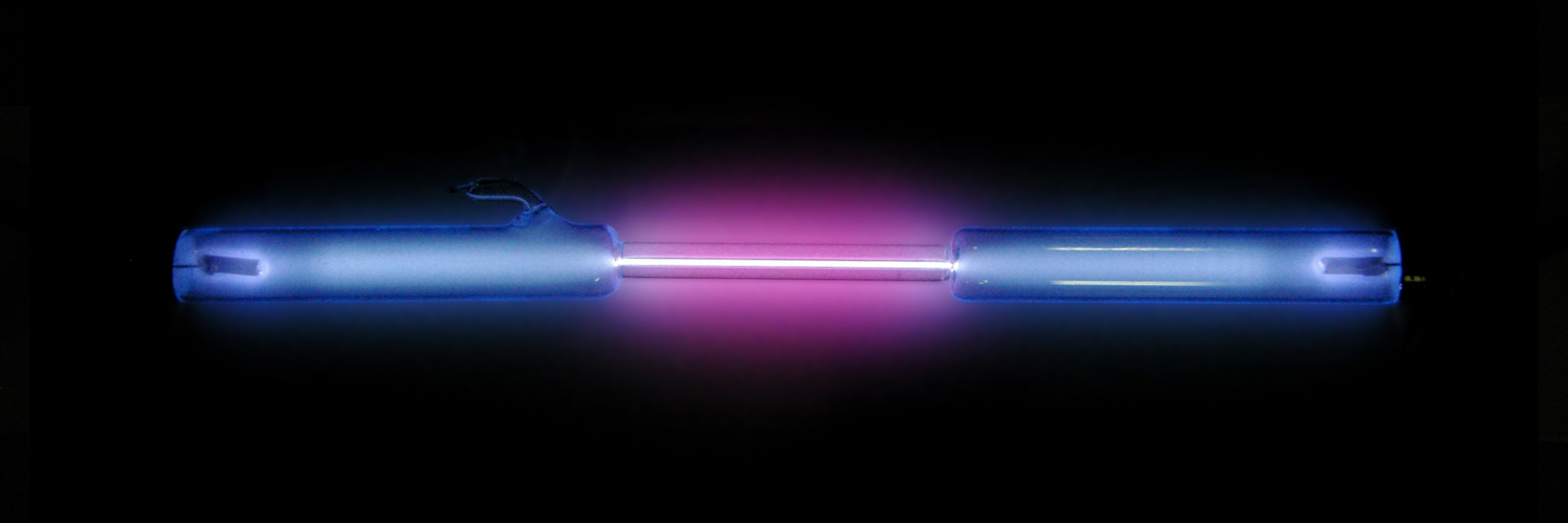|
Baryogenesis
In physical cosmology, baryogenesis (also known as baryosynthesis) is the physical process that is hypothesized to have taken place during the early universe to produce baryonic asymmetry, the observation that only matter (baryons) and not antimatter (antibaryons) is detected in universe other than in cosmic ray collisions. Since it is assumed in cosmology that the particles we see were created using the same physics we measure today, and in particle physics experiments today matter and antimatter are always symmetric, the dominance of matter over antimatter is unexplained. A number of theoretical mechanisms are proposed to account for this discrepancy, namely identifying conditions that favour symmetry breaking and the creation of normal matter (as opposed to antimatter). This imbalance has to be exceptionally small, on the order of 1 in every (≈) particles a small fraction of a second after the Big Bang. After most of the matter and antimatter was annihilated, what remaine ... [...More Info...] [...Related Items...] OR: [Wikipedia] [Google] [Baidu] [Amazon] |
Big Bang
The Big Bang is a physical theory that describes how the universe expanded from an initial state of high density and temperature. Various cosmological models based on the Big Bang concept explain a broad range of phenomena, including the abundance of light elements, the cosmic microwave background (CMB) radiation, and large-scale structure. The uniformity of the universe, known as the horizon and flatness problems, is explained through cosmic inflation: a phase of accelerated expansion during the earliest stages. A wide range of empirical evidence strongly favors the Big Bang event, which is now essentially universally accepted.: "At the same time that observations tipped the balance definitely in favor of the relativistic big-bang theory, ..." Detailed measurements of the expansion rate of the universe place the Big Bang singularity at an estimated billion years ago, which is considered the age of the universe. Extrapolating this cosmic expansion backward in ... [...More Info...] [...Related Items...] OR: [Wikipedia] [Google] [Baidu] [Amazon] |
Physical Cosmology
Physical cosmology is a branch of cosmology concerned with the study of cosmological models. A cosmological model, or simply cosmology, provides a description of the largest-scale structures and dynamics of the universe and allows study of fundamental questions about its Cosmogony, origin, structure, Chronology of the universe, evolution, and ultimate fate.For an overview, see Cosmology as a science originated with the Copernican principle, which implies that astronomical object, celestial bodies obey identical physical laws to those on Earth, and Newtonian mechanics, which first allowed those physical laws to be understood. Physical cosmology, as it is now understood, began in 1915 with the development of Albert Einstein's general relativity, general theory of relativity, followed by major observational discoveries in the 1920s: first, Edwin Hubble discovered that the universe contains a huge number of external Galaxy, galaxies beyond the Milky Way; then, work by Vesto Sliph ... [...More Info...] [...Related Items...] OR: [Wikipedia] [Google] [Baidu] [Amazon] |
Baryonic Asymmetry
In physical cosmology, the baryon asymmetry problem, also known as the matter asymmetry problem or the matter–antimatter asymmetry problem, is the observed imbalance in baryonic matter (the type of matter experienced in everyday life) and antibaryonic matter in the observable universe. Neither the standard model of particle physics nor the theory of general relativity provides a known explanation for why this should be so, and it is a natural assumption that the universe is neutral with all conserved charges. The Big Bang should have produced equal amounts of matter and antimatter. Since this does not seem to have been the case, it is likely some physical laws must have acted differently or did not exist for matter and/or antimatter. Several competing hypotheses exist to explain the imbalance of matter and antimatter that resulted in baryogenesis. However, there is as of yet no consensus theory to explain the phenomenon, which has been described as "one of the great mysteries ... [...More Info...] [...Related Items...] OR: [Wikipedia] [Google] [Baidu] [Amazon] |
Cosmological Phase Transition
A cosmological phase transition is an overall change in the state of matter across the whole universe. The success of the Big Bang model led researchers to conjecture possible cosmological phase transitions taking place in the very early universe, at a time when it was much hotter and denser than today. Any cosmological phase transition may have left signals which are observable today, even if it took place in the first moments after the Big Bang, when the universe was opaque to light. Character The Standard Model of particle physics, parameterized by values measured in laboratories, can be used to predict the nature of cosmic phase transitions. A system in the ground state at a high temperature changes as the temperature drops due to expansion of the universe. A new ground state may become favorable and a transition between the states is a phase transition. A phase transition can be related to a difference in symmetry between the two states. For example liquid is isotropic b ... [...More Info...] [...Related Items...] OR: [Wikipedia] [Google] [Baidu] [Amazon] |
Antimatter
In modern physics, antimatter is defined as matter composed of the antiparticles (or "partners") of the corresponding subatomic particle, particles in "ordinary" matter, and can be thought of as matter with reversed charge and parity, or going backward in time (see CPT symmetry). Antimatter occurs in natural processes like cosmic ray collisions and some types of radioactive decay, but only a tiny fraction of these have successfully been bound together in experiments to form antiatoms. Minuscule numbers of antiparticles can be generated at particle accelerators, but total artificial production has been only a few nanograms. No Macroscopic scale, macroscopic amount of antimatter has ever been assembled due to the extreme cost and difficulty of production and handling. Nonetheless, antimatter is an essential component of widely available applications related to beta decay, such as positron emission tomography, radiation therapy, and industrial imaging. In theory, a particle and ... [...More Info...] [...Related Items...] OR: [Wikipedia] [Google] [Baidu] [Amazon] |
Baryon Number
In particle physics, the baryon number (B) is an additive quantum number of a system. It is defined as B = \frac(n_\text - n_), where is the number of quarks, and is the number of antiquarks. Baryons (three quarks) have B = +1, mesons (one quark, one antiquark) have B = 0, and antibaryons (three antiquarks) have B = −1. Exotic hadrons like pentaquarks (four quarks, one antiquark) and tetraquarks (two quarks, two antiquarks) are also classified as baryons and mesons depending on their baryon number. In the standard model B conservation is an accidental symmetry which means that it appears in the standard model but is often violated when going beyond it. Physics beyond the Standard Model theories that contain baryon number violation are, for example, Standard Model with extra dimensions, Supersymmetry, Grand Unified Theory and String theory. Baryon number vs. quark number Quarks carry not only electric charge, but also charges such as color charge and weak iso ... [...More Info...] [...Related Items...] OR: [Wikipedia] [Google] [Baidu] [Amazon] |
Grand Unification Epoch
In physical cosmology, the grand unification epoch is a poorly understood period in the evolution of the early universe following the Planck epoch and preceding inflation. This places it between about 10−43 seconds after the Big Bang and 10−35 seconds, when the temperature of the universe was comparable to the characteristic temperatures of grand unified theories. However, these theories have not been successful producing quantitative agreement with the results of modern astrophysical observations. If the grand unification energy is taken to be 1015 GeV, this corresponds to temperatures higher than 1027 K. During this period, three of the four fundamental interactions — electromagnetism, the strong interaction, and the weak interaction — were unified as the electronuclear force. Gravity had separated from the electronuclear force at the end of the Planck era. During the grand unification epoch, physical characteristics such as mass, charge, flavour and colour ... [...More Info...] [...Related Items...] OR: [Wikipedia] [Google] [Baidu] [Amazon] |
Grand Unified Theory
A Grand Unified Theory (GUT) is any Mathematical model, model in particle physics that merges the electromagnetism, electromagnetic, weak interaction, weak, and strong interaction, strong fundamental interaction, forces (the three gauge theory, gauge interactions of the Standard Model) into a single force at high energy, energies. Although this Unification (physics), unified force has not been directly observed, many GUT models theorize its existence. If the unification of these three interactions is possible, it raises the possibility that there was a grand unification epoch in the Chronology of the universe#Very early universe, very early universe in which these three fundamental interactions were not yet distinct. Experiments have confirmed that at high energy, the electromagnetic interaction and weak interaction unify into a single combined electroweak interaction. GUT models predict that at even grand unification energy, higher energy, the strong and electroweak interaction ... [...More Info...] [...Related Items...] OR: [Wikipedia] [Google] [Baidu] [Amazon] |
Proton Decay
In particle physics, proton decay is a hypothetical form of particle decay in which the proton decays into lighter subatomic particles, such as a neutral pion and a positron. The proton decay hypothesis was first formulated by Andrei Sakharov in 1967. Despite significant experimental effort, proton decay has never been observed. If it does decay via a positron, the proton's half-life is constrained to be at least . According to the Standard Model, the proton, a type of baryon, is stable because baryon number ( quark number) is conserved (under normal circumstances; see ''Chiral anomaly'' for an exception). Therefore, protons will not decay into other particles on their own, because they are the lightest (and therefore least energetic) baryon. Positron emission and electron capture—forms of radioactive decay in which a proton becomes a neutron—are not proton decay, since the proton interacts with other particles within the atom. Some beyond-the-Standard-Model grand unifi ... [...More Info...] [...Related Items...] OR: [Wikipedia] [Google] [Baidu] [Amazon] |
X Boson
In particle physics, the X and Y bosons (sometimes collectively called "X bosons" ) are hypothetical elementary particles analogous to the W and Z bosons, but corresponding to a unified force predicted by the Georgi–Glashow model, a grand unified theory (GUT). Since the X and Y boson mediate the grand unified force, they would have unusual high mass, which requires more energy to create than the reach of any current particle collider experiment. Significantly, the X and Y bosons couple quarks (constituents of protons and others) to leptons (such as positrons), allowing violation of the conservation of baryon number thus permitting proton decay. However, the Hyper-Kamiokande has put a lower bound on the proton's half-life as around 1034 years. Since some grand unified theories such as the Georgi–Glashow model predict a half-life ''less'' than this, the existence of X and Y bosons, as formulated by this particular model, remains hypothetical. Details An X bos ... [...More Info...] [...Related Items...] OR: [Wikipedia] [Google] [Baidu] [Amazon] |
Baryon
In particle physics, a baryon is a type of composite particle, composite subatomic particle that contains an odd number of valence quarks, conventionally three. proton, Protons and neutron, neutrons are examples of baryons; because baryons are composed of quarks, they belong to the hadron list of particles, family of particles. Baryons are also classified as fermions because they have half-integer Spin (physics), spin. The name "baryon", introduced by Abraham Pais, comes from the Ancient Greek, Greek word for "heavy" (βαρύς, ''barýs''), because, at the time of their naming, most known elementary particles had lower masses than the baryons. Each baryon has a corresponding antiparticle (antibaryon) where their corresponding antiquarks replace quarks. For example, a proton is made of two up quarks and one down quark; and its corresponding antiparticle, the antiproton, is made of two up antiquarks and one down antiquark. Baryons participate in the residual strong force, which ... [...More Info...] [...Related Items...] OR: [Wikipedia] [Google] [Baidu] [Amazon] |
Matter
In classical physics and general chemistry, matter is any substance that has mass and takes up space by having volume. All everyday objects that can be touched are ultimately composed of atoms, which are made up of interacting subatomic particles. In everyday as well as scientific usage, ''matter'' generally includes atoms and anything made up of them, and any particles (or combination of particles) that act as if they have both rest mass and volume. However it does not include massless particles such as photons, or other energy phenomena or waves such as light or heat. Matter exists in various states (also known as phases). These include classical everyday phases such as solid, liquid, and gas – for example water exists as ice, liquid water, and gaseous steam – but other states are possible, including plasma, Bose–Einstein condensates, fermionic condensates, and quark–gluon plasma. Usually atoms can be imagined as a nucleus of protons and neu ... [...More Info...] [...Related Items...] OR: [Wikipedia] [Google] [Baidu] [Amazon] |




